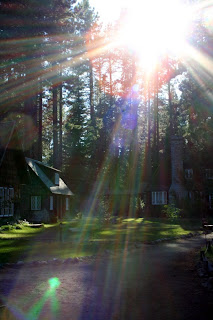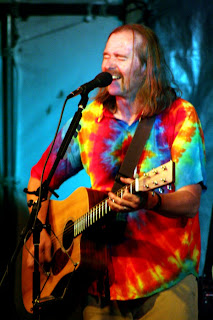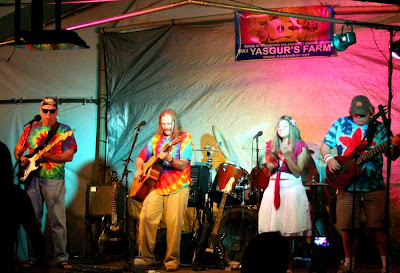
Yes, I'm cooking. From recent posts, it may not seem that way. Except for two meals, I really haven't prepared anything unique.

As you can see from by blogs this week, photography and hiking (the two go hand-in-hand) have occupied much of my time. After shooting the
Glen Alpine Resort in the full noon sun, I thought it'd be nice to shoot during the "magic hours" when brilliant images flow out of your camera.
Even skilled photographers have difficulty shooting when the sun is high in the sky. Images easily wash out. You can only add so much compensation to a picture that features a corrugated tin roof before it's underexposed.
There are two magic hours -- one at sunrise and the other at sunset. The quality of your photographs will amaze you when you shoot 30 to 60 minutes after the sunrise or before sunset. It's also called the golden hours because of the warm, saturated colors associated with the beginning and end of the day.

With sunrise just after 6 a.m., I haven't managed to wake up early yet. I'm enjoying a week of sleeping in until 7 or 8 each morning. I may rise early tomorrow or Friday morning.
It's much easier to eat an early dinner and catch the setting sun. We left camp at 5 O'clock and walked through the Tallac Estates. Shooting in the late afternoon sun was a good exercise in adjusting for lighting challenges of the late afternoon.
I shot a few semi-successful pictures directly into the sun as it dropped into the trees over the Pope House (see photo to right). I certainly need to improve.
After our stroll through the Tallac historic site, we drove up to the Angora Ridge Lookout to shoot the sunset. I posted my most successful photograph yesterday
here.
So much for photography. Let's turn to beef stew. This is a food blog, after all.
A richly flavored stew is the perfect dish for a lazy day in camp. A sturdy cast iron Dutch oven, plenty of hot coals from the fire and a little patience is all you need to turn a chuck roast into tender cubes in a rich gravy. This recipe has a nice Mediterranean flare it it with the addition of sundried tomato pesto and pepperincini peppers.
You don't need top heat for this recipe. Bottom heat is sufficient since the stew is gently simmered over a hot fire for one to two hours. Control the heat by adjusting the concentration of coals under the pot. Add hot coals under the pot if the stew isn't simmering.
If it's simmering vigorously or boiling, remove coals and set them aside. You should see a gentle simmer, with bubble barely breaking the surface.
I use 2 to 3 pounds of chuck roast for my stews. The amount depends on the quantity of meat in the package. Adjust the amount of beef stock or broth accordingly. You don't need a lot of extra gravy with this stew recipe since it doesn't call for potatoes or carrots.
 BEEF STEW WITH SUNDRIED TOMATO PESTO
BEEF STEW WITH SUNDRIED TOMATO PESTO2-1/2 pounds chuck roast, cut into 3/4-inch cubes
Salt and black pepper, to taste
1 cup all-purpose flour
2-3 tablespoons olive oil
1/2 large onion, chopped
3 cloves garlic, minced
2-3 cups beef stock or broth
4 tablespoons sundried tomato pesto
6 pepperincini peppers, stems removed and chopped
1 large bay leaf
1/4 teaspoon crushed red pepper
1-1/2 teaspoons dried thyme
Pre-heat 6- to 8-quart Dutch oven over a hot fire. Lightly season cubed beef chuck roast with salt and ground black pepper. Dredge seasoned beef in flour. Shake off excess flour and set aside. Reserve remaining flour.
Add half the olive oil to the hot oven. Brown beef in in hot oil in 2 batches to avoid overcrowding. Remove each batch of beef to a plate after it is browned. Use the remaining oil for the second batch. Saute onions in hot oil until tender.
Return browned beef to Dutch oven. Add beef stock or broth, sundried tomato pesto, pepperincini peppers, bay leaves, crushed red pepper and thyme to Dutch oven. Stir, replace lid and set inside oven. Gently simmer for about 1 to 1-1/2 hours, until beef it tender.
Prepare a slurry by whisking the remaining dredging flout into cold water. Remove lid and pour slurry into stew. Immediately stir until thickened. Replace lid and return to oven and simmer 10 to 15 minutes. Thin with beef stock or broth is too thick.
Total cooking time for the stew will be approximately 1-1/2 to 2 hours. Serve over mashed red potatoes or penne pasta. Serves 6 to 8 (1-cup) portions.
 PACIFIC OCEAN (Aug. 4, 2007) - Civilian culinary instructor Jeff Hadley gives Culinary Specialists a demonstration on food presentation aboard Arleigh Burke-class guided-missile destroyer USS John S. McCain (DDG 56). Hadley has volunteered his time to help instruct Navy culinary specialists for the past two summers. While deployed, McCain is under the operational control of Destroyer Squadron 15.
PACIFIC OCEAN (Aug. 4, 2007) - Civilian culinary instructor Jeff Hadley gives Culinary Specialists a demonstration on food presentation aboard Arleigh Burke-class guided-missile destroyer USS John S. McCain (DDG 56). Hadley has volunteered his time to help instruct Navy culinary specialists for the past two summers. While deployed, McCain is under the operational control of Destroyer Squadron 15. 


 At about 20 minutes past the six o'clock, I knew I had captured my sunrise when the image on the LCD monitor jumped out of the camera. I was rewarded with a fiery red reflection as the waves rippled toward the shore.
At about 20 minutes past the six o'clock, I knew I had captured my sunrise when the image on the LCD monitor jumped out of the camera. I was rewarded with a fiery red reflection as the waves rippled toward the shore.

 Yes, I'm cooking. From recent posts, it may not seem that way. Except for two meals, I really haven't prepared anything unique.
Yes, I'm cooking. From recent posts, it may not seem that way. Except for two meals, I really haven't prepared anything unique.









